Alan Roelfs visits CIMMYT to teach about rust
CIMMYT-El Batán had the privilege to host Alan Roelfs, an expert on rust research, as a visitor to the wheat program. Roelfs assisted with training as part of the “Advanced Wheat Improvement Course: Pathology Module” during 25 July – 15 August 2012. “Alan Roelfs equals rust,” said CIMMYT wheat pathologist Amor Yahyaoui, summarizing the significance of Roelfs’ expertise and fame.
Roelfs began working on wheat leaf rust as research aide for the US Department of Agriculture (USDA) at Kansas State University, and later transferred to the Cooperative Rust Lab in Minnesota. At USDA he studied stem rust resistance, helped to modernize the stem rust race survey, and monitored spore and disease movement from Mexico to Canada. Roelfs first visited CIMMYT while at Minnesota. “CIMMYT was very different. The wheat and corn programs are now more blended,” he said about his first experiences in Mexico. Roelfs commended the role of CIMMYT in helping Mexico achieve self-sufficiency in wheat production: “Back then it was about improving the crop or not eating.”
A part of Roelfs’ work in Mexico was to track diseases and compare them to CIMMYT’s collection. “Field monitoring of leaf and stem rust populations was significantly different from what it is now,” says Roelfs. “Rust research is also now more like playing with genetics―trying to find out how to turn a trait on or off, depending on what we need it to do.”
Roelfs has visited CIMMYT frequently to attend scientific meetings or offer information on rust lines, and played a key role in the beginning of rust research at CIMMYT. For training, he draws on his vast experience with students with different abilities and backgrounds: “CIMMYT trainings are a very challenging task from the instructor’s perspective because the group is very diverse. There are people with PhD degrees and little field experience, along with people with purely practical experience. Furthermore, there are language barriers, as participants come from different countries.”
Besides training and scientific meetings, Roelfs is also working with CIMMYT scientists on a new edition of Rust Diseases of Wheat: Concepts and Methods of Disease Management, which was first published by CIMMYT in 1992. The new edition will include discoveries from the last 20 years.
 On 1 and 2 August 2012, representatives of public and private organizations interested in developing information technologies for the agricultural sector met at CIMMYT to participate in the MasAgro Movil Think Tank.
On 1 and 2 August 2012, representatives of public and private organizations interested in developing information technologies for the agricultural sector met at CIMMYT to participate in the MasAgro Movil Think Tank.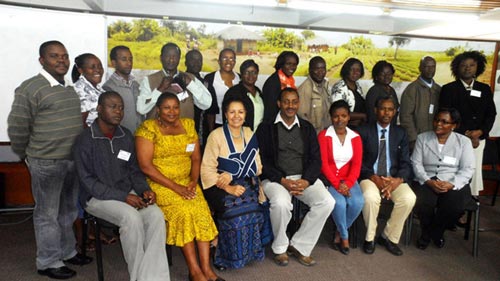
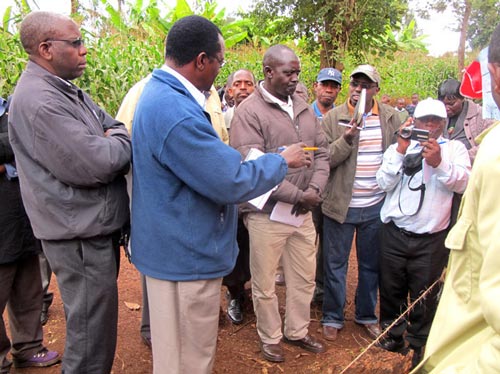 A delegation of scientists from South Sudan, Rwanda, and Uganda —the spillover countries of the Sustainable Intensification of Maize-Legume Systems for Food Security in Eastern and Southern Africa (SIMLESA) initiative— visited Embu, Kenya, during 18-20 July 2012, to gain hands-on experience in implementing the program and to learn about its impact on livelihoods of smallholder farmers.
A delegation of scientists from South Sudan, Rwanda, and Uganda —the spillover countries of the Sustainable Intensification of Maize-Legume Systems for Food Security in Eastern and Southern Africa (SIMLESA) initiative— visited Embu, Kenya, during 18-20 July 2012, to gain hands-on experience in implementing the program and to learn about its impact on livelihoods of smallholder farmers.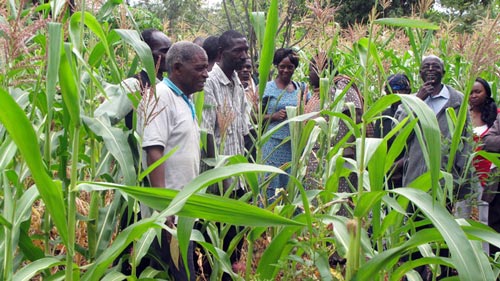
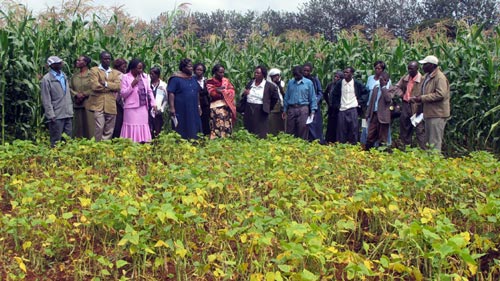
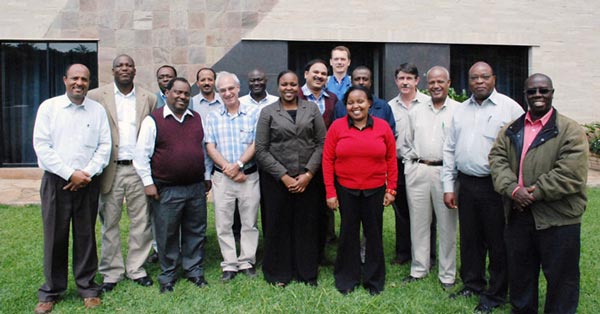
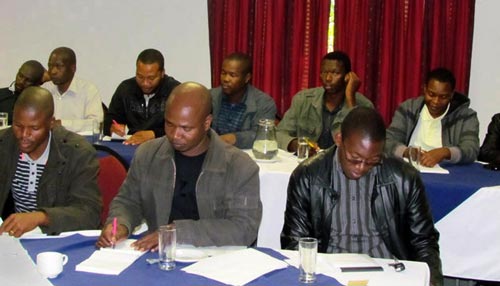 During 25 – 30 June 2012, CRP MAIZE and FAO-Swaziland supported the participation of 32 maize researchers and technicians in a maize training course in Mbabane, Swaziland. The course attracted agricultural researchers and extension staff from the Department of Agricultural Research and Special Services (DARSS), NGOs, and seed companies.
During 25 – 30 June 2012, CRP MAIZE and FAO-Swaziland supported the participation of 32 maize researchers and technicians in a maize training course in Mbabane, Swaziland. The course attracted agricultural researchers and extension staff from the Department of Agricultural Research and Special Services (DARSS), NGOs, and seed companies. 
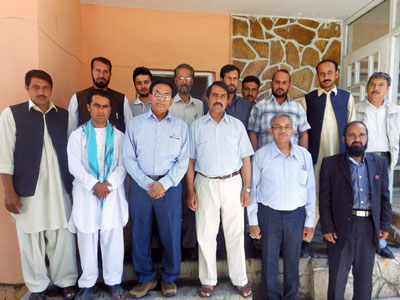 Dr. Mishra began the course by reviewing basic statistical concepts and discussing the statistical tools and concepts needed to design and analyze field experiments that would lead to scientifically valid interpretations. He went on to describe how to choose experimental designs, lay out field experiments, and analyze and interpret the results. He had the participants do useful exercises as well as analyze data for hands-on experience. All the participants were keenly interested and excited to have the opportunity to analyze and interpret data from their own experiments. The general feeling at the end of the two-day event was that it should have lasted at least a week. Upon presenting certificates to course participants, Mr. Qasem Obaidi, ARIA Director, thanked Dr. Mishra and CIMMYT for the capacity building effort and expressed his wish that a follow-up course be held to help consolidate the gains and enable Afghan researchers to learn more about experimental design and analysis.
Dr. Mishra began the course by reviewing basic statistical concepts and discussing the statistical tools and concepts needed to design and analyze field experiments that would lead to scientifically valid interpretations. He went on to describe how to choose experimental designs, lay out field experiments, and analyze and interpret the results. He had the participants do useful exercises as well as analyze data for hands-on experience. All the participants were keenly interested and excited to have the opportunity to analyze and interpret data from their own experiments. The general feeling at the end of the two-day event was that it should have lasted at least a week. Upon presenting certificates to course participants, Mr. Qasem Obaidi, ARIA Director, thanked Dr. Mishra and CIMMYT for the capacity building effort and expressed his wish that a follow-up course be held to help consolidate the gains and enable Afghan researchers to learn more about experimental design and analysis.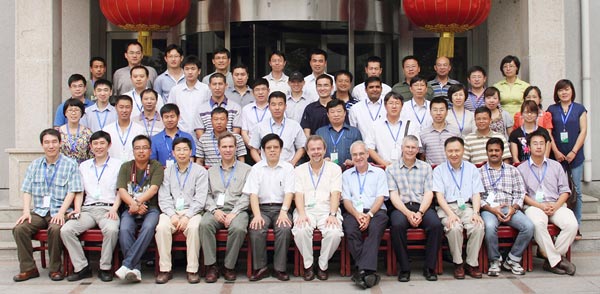
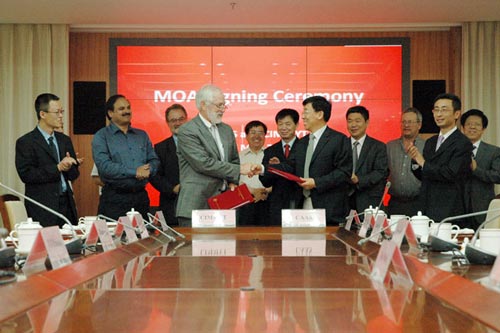 As indicated in Ren Wang’s speech, CIMMYT has the largest investment in China among CGIAR centers. Five collaborative research programs led by CIMMYT scientists stationed in China have been established at CAAS, Yunnan and Sichuan. This has created a new model for CGIAR-China collaboration and increased CIMMYT’s impact in China. CIMMYT is also the first international center to establish collaborative projects with the National Natural Science Foundation of China.
As indicated in Ren Wang’s speech, CIMMYT has the largest investment in China among CGIAR centers. Five collaborative research programs led by CIMMYT scientists stationed in China have been established at CAAS, Yunnan and Sichuan. This has created a new model for CGIAR-China collaboration and increased CIMMYT’s impact in China. CIMMYT is also the first international center to establish collaborative projects with the National Natural Science Foundation of China.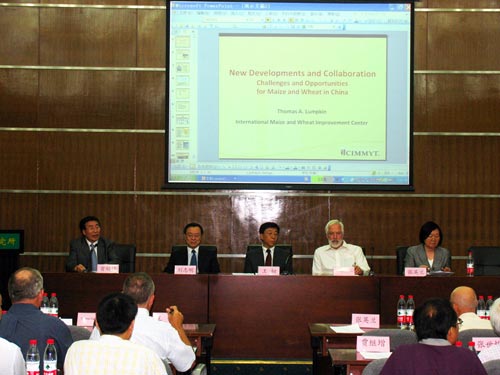 Bed planting has produced significant impact in the provinces of Gansu, Ningxia, Sichuan, Shandong, and Henan, bringing among other benefits a 30% reduction in input use. Bed planting is particularly advantageous at saving water. Conservation agriculture techniques combined with new winter wheat varieties have been broadly extended in traditional spring wheat areas, allowing farmers to take advantage of climate change to increase yields and reduce input use.
Bed planting has produced significant impact in the provinces of Gansu, Ningxia, Sichuan, Shandong, and Henan, bringing among other benefits a 30% reduction in input use. Bed planting is particularly advantageous at saving water. Conservation agriculture techniques combined with new winter wheat varieties have been broadly extended in traditional spring wheat areas, allowing farmers to take advantage of climate change to increase yields and reduce input use. One of the worst wheat diseases in China, stripe rust has appeared in yearly epidemics since 1950 and caused losses of more than 60 million tons. As China is among the world’s main producers of wheat, the CIMMYT China office in Chengdu, in collaboration with the Sichuan Academy of Agricultural Sciences (SAAS), organized a two-day workshop to address these issues.
One of the worst wheat diseases in China, stripe rust has appeared in yearly epidemics since 1950 and caused losses of more than 60 million tons. As China is among the world’s main producers of wheat, the CIMMYT China office in Chengdu, in collaboration with the Sichuan Academy of Agricultural Sciences (SAAS), organized a two-day workshop to address these issues.